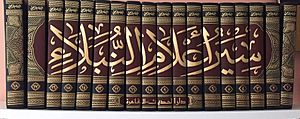Al-Dhahabi facts for kids
Quick facts for kids Adh-Dhahabīالذھبی |
|
|---|---|
| Religion | Islam |
| Denomination | Sunni |
| Personal | |
| Born | 5 October 1274 Damascus, Mamluk Sultanate now Syria |
| Died | 3 February 1348 (aged 73) Damascus, Mamluk Sultanate now Syria |
| Influenced | Ibn Kathir, Taj al-Din al-Subki |
Shams ad-Dīn adh-Dhahabī (شمس الدين الذهبي) was a very important Islamic historian and expert on Hadith from Syria. His full name was Shams ad-Dīn Abū ʿAbdillāh Muḥammad ibn Aḥmad ibn ʿUthmān ibn Qāymāẓ ibn ʿAbdillāh at-Turkumānī al-Fāriqī ad-Dimashqī. He was born in October 1274 and passed away on February 3, 1348, at the age of 73.
Contents
Life of Adh-Dhahabī
Adh-Dhahabī was born in Damascus, a major city in Syria, on October 5, 1274. His family came from a group of people called Turkmen, from a place called Mayyafariqin. Later, his family moved to Damascus. His last name, adh-Dhahabī, means "son of the goldsmith," which tells us what his father did for a living.
He started studying hadith (sayings and actions of Prophet Muhammad) when he was eighteen years old. To learn more, he traveled a lot. He visited many cities like Baalbek, Homs, Hama, Aleppo, Nabulus, Cairo, Alexandria, Jerusalem, and Hijaz. After his travels, he came back to Damascus to teach and write.
Adh-Dhahabī wrote many books and was known as a very smart critic and expert on hadith. He wrote a huge history book that included biographies of many important people. He was also the top expert on how to correctly read the Qur'an. Interestingly, some of his teachers were women, like Zaynab bint ʿUmar b. al-Kindī in Baalbek, who greatly influenced him.
Sadly, Adh-Dhahabī lost his eyesight two years before he died. He had three children: a daughter named Amat al-`Aziz, and two sons, `Abd Allah and Abu Hurayra `Abd al-Rahman. His son, Abu Hurayra `Abd al-Rahman, later taught other famous hadith scholars like Ibn Hajar. Through his son, many of Adh-Dhahabī's works were passed on.
Adh-Dhahabī's Teachers
Adh-Dhahabī learned from many great scholars in different subjects like hadith, fiqh (Islamic law), and aqida (Islamic beliefs). Here are some of his most important teachers:
- Abd al-Khaliq bin ʿUlwān
- Zaynab bint ʿUmar bin al-Kindī
- Abu al-Hasan ‘Ali ibn Mas‘ud ibn Nafis al-Musali
- Ibn Taymiyyah Taqi ad-Din Ahmad ibn Taymiyyah
- Ibn al-Zahiri, Ahmad ibn Muhammad ibn `Abd Allah al-Halabi
- Sharaf-ud-din Abd al-Mu'min ibn Khalaf al-Dimyati, who was the leading hadith expert in Egypt at his time.
- Shaykh al-Islam Ibn Daqiq al-'Id, a very respected scholar.
- Jamal-ud-din Abu al-Ma`ali Muhammad ibn `Ali al-Ansari al-Zamalkani al-Damishqi al-Shafi`i, whom Adh-Dhahabī called "the Paragon of Islam."
- Ahmad ibn Ishaq ibn Muhammad al-Abarquhi al-Misri
- Ibn al-Kharrat al-Dawalibi
Famous Students of Adh-Dhahabī
Adh-Dhahabī also had many famous students who became important scholars themselves. Some of them include:
- Imad ad-Din Isma'il bin 'Umar bin Kathir
- Zain ad-Din 'Abd ar-Rahmān ibn al-Hasan as-Sulamī (Ibn Rajab)
- Shams-ud-din Abu al Mahasin Muhammad ibn Ali al-Dimashqi
- Ibn Asakir Tāj al-Dīn al-Subkī
- Khalīl ibn Aybak al-Ṣafadī
- Ibn al-Furat
Adh-Dhahabī's Works
Adh-Dhahabī wrote almost a hundred books! These books covered history, biographies (life stories of people), and theology (the study of religious beliefs). He even wrote about the history of medicine, starting with ancient Greek and Indian practices, and then moving to "prophetic medicine" (medical knowledge from Prophet Muhammad) and the works of scholars like Ibn Sina.
Here are some of his most well-known books:
- Tarikh al-Islam al-kabir (تاريخ الإسلام), which means 'Great History of Islam'. This huge work has 50 volumes and includes over 30,000 biographies!
- Siyar a`lam al-nubala (سير أعلام النبلاء), which means 'The Lives of Noble Figures'. This book has 28 volumes and is like an encyclopedia of important historical figures.
- Al-`Ibar fī khabar man ghabar (العبر في خبر من غبر ويليه ذيول العبر)
- Tadhhib Tahdhib al-Kamal, which is a shorter version of another important book about hadith narrators.
- Al-Kashif fi Ma`rifa Man Lahu Riwaya fi al-Kutub al-Sitta
- Al-Mujarrad fi Asma' Rijal al-Kutub al-Sitta
- Al-Amsar Dhawat al-Athar (Cities Rich in Historical Relics), which starts by describing the city of Madina al-Munawwara.
- Al-Tajrid fi Asma' al-Sahaba, a dictionary of the Companions of Prophet Muhammad.
- Tabaqat al-Qurra (Categories of the Qur'anic Scholars), a collection of biographies of scholars who specialized in the Quran.
- Al-Mu`in fi Tabaqat al-Muhaddithin, a book about hadith scholars.
- Duwal al-Islam (The Islamic Nations), which gives short histories of different Islamic nations.
- Al-Kaba'ir (Cardinal Sins)
- Mizaan-ul-I’tidaal, a revised version of another book about hadith narrators.


